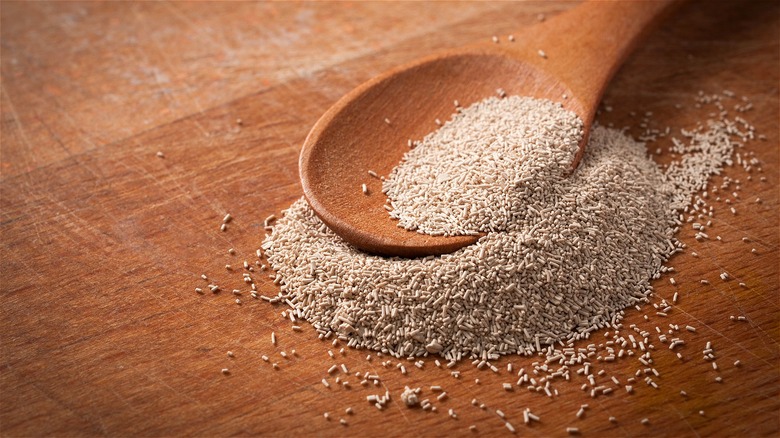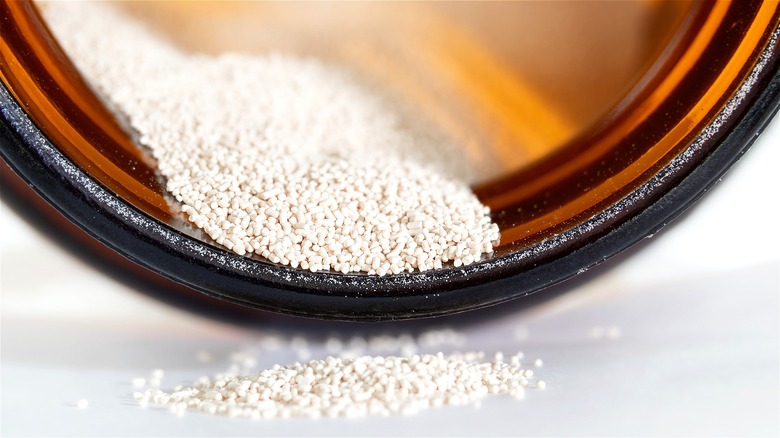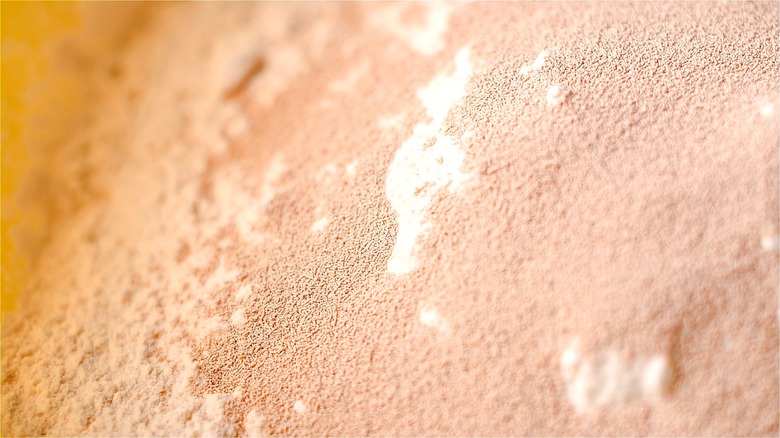Instant Vs Active Yeast: What's The Difference?
Among many necessities that at-home bakers swear by, yeast is a quintessential staple. If you often find yourself mixing bread flour, salt, and warm water to make yet another loaf of Pullman bread, you probably have a safe store of yeast tucked away somewhere in your refrigerator. While yeast adds height to all your favorite bread recipes, these tiny microorganisms also add structure and stability to different baked goods. Yet, choosing the best-packaged yeast for all your favorite glutenous recipes may cause more confusion than necessary.
Regarding the most common types of yeast available at your neighborhood supermarket, those labeled active and instant are, without a doubt, the most popular varieties. If you're curious about what makes active yeast different from instant yeast, the former requires activation with the help of a warm liquid and a small amount of sugar. Instant yeast, on the other hand, is active from the start due to its finely ground consistency; this product can be added to dry ingredients and have the same effect on your dough as active yeast. In truth, active and instant yeast is the same ingredient, yet the latter has been broken down further for immediate use. Surprisingly, active and instant yeast can be used interchangeably, but there are subtle differences between the two varieties, lending to an ultimate preference for one over the other.
Active and instant yeast are distinct in both rise time and shelf life
Before you decide which yeast to choose for your next loaf of raisin sandwich bread, consider your recipe's instructions. Even though active yeast and instant yeast are quite similar, depending on which variety you use, there will be a slight impact on preparation and rise time. Active yeast should be added to any included liquids first, while instant yeast may be added directly to your mixing bowl with the other included ingredients. While you can substitute active yeast with instant yeast on a 1:1 ratio, expect to reduce your rise time by 10-15 minutes when using instant. Depending on the temperature of your house, the difference in rise time may often fluctuate. As long as you feel comfortable using your culinary instincts and visually deciding when your bread has risen or doubled as directed, swapping out one product for the other shouldn't be an issue.
If you're looking to speed up your weekly bread baking, turning to instant yeast might feel like a no-brainer. However, you should always check the expiration dates of any packaged yeast to ensure freshness. Both instant and active yeast are shelf-stable for two years, yet there is no solid way to tell if your instant yeast has gone bad, especially if you're always adding it directly into a dry mixture of flour and salt. Does instant yeast have the same perishability as active yeast?
Instant yeast may be more reliable than active yeast
Depending on how much time you allot to making simple classic pizza crust and other bready favorites, instant yeast may be your best bet if you choose a less finicky product for spoilage and long-term longevity. Active yeast tends to spoil at a faster rate than instant and may even die long before its expiration date due to temperature restraints. Instant yeast has been proven to show more consistency overall and can be purchased in larger quantities and frozen for easy and convenient use, making this product cheaper if bought in bulk.
While one isn't technically better than the other, there are benefits and drawbacks to both varieties. However, if you decide to use instant yeast, make sure you know the differences between instant and rapid-rise or quick-acting yeast. While instant yeast may accommodate doughs with a longer fermentation time, fast-acting varieties are meant for same-day baking. When using one of these quick-acting products, your loaves of bread may also be shaped directly after kneading. There's a lot to take into account when choosing the suitable yeast for your favorite recipes. Consider how much time you typically give yourself to bake as well as your comfort level in the kitchen; these factors alone may help you hone in on the suitable yeast for your everyday baking needs.


